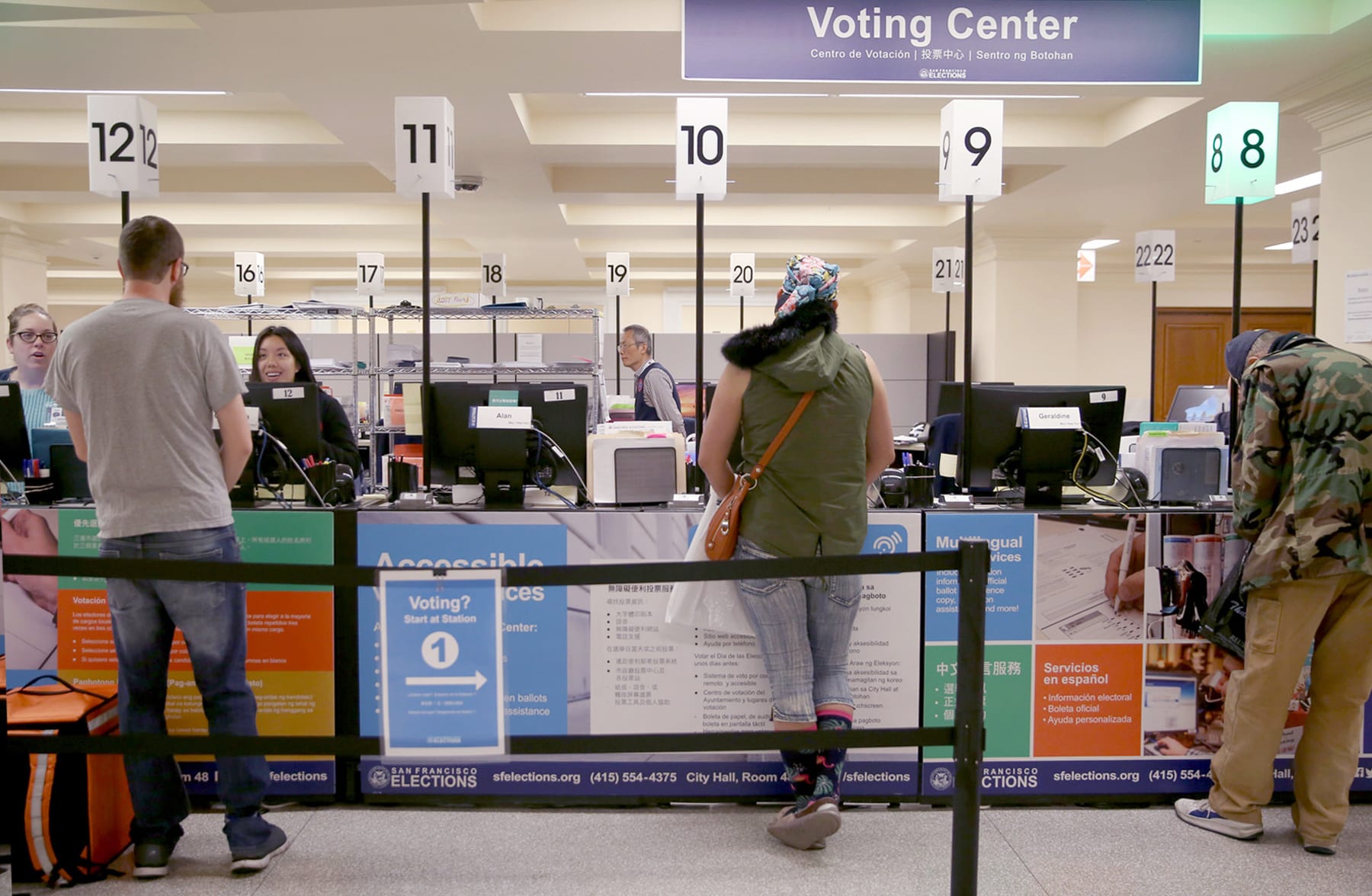One of Susan Lerner’s favorite moments of this year’s New York City mayoral race happened toward the end of a Democratic candidate debate in May, when — assuming their first choice would be themselves — the participating contenders were asked about their second choice for the job.
Of the eight candidates, four said they were still weighing their options. But the others named a combination of the three leading women candidates at the time, recognizing that under the city’s new ranked-choice voting, their answers could provide value to supporters.
“Just the fact that that question is being asked, I think, is indicative of a change in mindset,” said Lerner, executive director of New York Common Cause, a national organization that has been educating voters about the system.
Ranked-choice voting has been a boon for underrepresented candidates: Women and people of color’s representation in elected politics has grown in communities that have implemented the system in recent years, potentially creating another solution to reach gender parity and inclusive representation more quickly in local, state and federal elections. And it could help make history when New York City voters finish casting ballots in the mayoral primary election Tuesday: A woman has never been elected mayor of America’s largest city, and only one person of color has ever held the job.
Here’s how ranked-choice voting works: A candidate wins outright if they receive over 50 percent of the vote. If no candidate reaches that threshold, the candidate with the fewest votes as a first-choice candidate is eliminated and those voters’ second choice is added into the mix. The process repeats until a candidate gets a majority of the vote. In the New York City mayoral race, voters can choose up to five candidates — Eric Adams, Shaun Donovan, Kathryn Garcia, Ray McGuire, Dianne Morales, Scott Stringer, Maya Wiley and Andrew Yang are among the leading candidates in a packed primary — though they can also just choose one.
New York City voters approved ranked-choice in 2019, and this year will mark its first use in the city in the modern political era. Some civic engagement groups have announced multi-candidate endorsements, while candidates themselves openly complimented some of their competitors, particularly earlier in the race.
Some voting experts believe ranked-choice voting has lowered barriers for candidates who are women or people of color. The single-winner plurality system that dominates American politics often favors incumbents, can lead to more expensive campaigns and run-offs and, most importantly, can create the narrative that two or more women candidates or candidates of color with similar priorities will split the vote for like-minded voters.
“Ranked-choice voting elections can accommodate multiple women candidates without having to pigeonhole these candidates as just the one woman running,” said Deb Otis, a senior research analyst at FairVote, a national organization that has studied ranked-choice voting and previously partnered with RepresentWomen.
“If we’re electing folks with ranked-choice voting, they’re more accountable to the needs of their voters or else they lose their seats,” said Otis, who co-authored a recent report that looked at the effects of ranked-choice voting on people of color candidates and voters. “They have to build a campaign that speaks to a broad base of voters rather than pandering to any one niche base. So we can definitely get more accountable elected officials and a reduction of polarization by changing the way that we elect our officials.”
Cynthia Richie Terrell, founder and director of RepresentWomen, pointed to the recent Democratic gubernatorial race in Virginia, where state Sen. Jennifer McClellan and former state Del. Jennifer Carroll Foy — Black women who would have made history if either had won the nomination and were elected — ran alongside Terry McAuliffe, a former governor who is a White man.
Richie Terrell emphasized that it’s not clear if ranked-choice voting would have changed the outcome of the race given McAuliffe’s strong lead going into the primary. But she believes more civic engagement groups would have made multi-candidate endorsements that could have raised the profiles of McClellan, Carroll Foy and others in the race. McAuliffe, who had the backing of several Black lawmakers and leaders, also might have sought even more support from voters who backed McClellan and Carroll Foy to ensure he was their second choice.
“McAuliffe might have felt more pressure from needing to appeal to Black woman voters and be attentive to their needs and their concerns. Because in order to win a majority he would have had to have said, ‘I’m really prioritizing the concerns of Black women in my agenda for the economy, for transportation, for health care, for child care,’” she said.
In the contentious world of politics, a crowded race for elected office can sometimes mean trouble for lesser known candidates, who are often women and people of color. They must then contend with narratives about their electability, placing them into a cycle of low name recognition and fundraising.
Courtney Lamendola, research director at RepresentWomen, said ranked-choice voting gives room for candidates to focus on the issues instead of questions about their viability.
“I think particularly for women and people of color, or really anybody else who has previously been excluded from this political process, it’s a really exciting and hopeful kind of opportunity for them,” she said.
The use of ranked-choice voting in the United States is currently most expansive in local politics. At least 19 cities and counties have used ranked-choice voting in the last decade to determine their municipal elections. Preliminary research from RepresentWomen shows women and people of color candidates win in higher numbers under a ranked-choice voting system. The report noted that at the start of 2020, half of all mayors and nearly half of all city council members elected in cities with ranked-choice voting are women.
Additionally, at least seven cities with ranked-choice voting for their city council elections have reached gender parity or surpassed it.
This kind of system isn’t new. A version of multi-winner voting was in use beginning around the 1910s in America, an extension of similar systems in Europe and other parts of the world. In the 1930s, New York City adopted a proportional version of multi-winner choice voting and before the end of the decade elected its first woman to the City Council, Genevieve Beavers Earle.
As more women and people of color won elections under a version of ranked-choice voting, powerful politicians began opposing its use.
“The sad reality is that it was a victim of its own success to a certain extent, because it threatened the establishment by giving voters more power to elect candidates of choice,” Richie Terrell said.
But ranked-choice voting is coming around again, and it is continuing to grow on the state and federal level. Maine voters in 2016 approved ranked-choice voting for state and federal elections, and its state legislature expanded its use for presidential elections. Janet Mills, the first woman elected governor of Maine, won a seven-way primary under ranked-choice voting in 2018.
Alaska voters approved ranked-choice voting last year, and additional states are implementing its use for presidential primary elections or allowing its cities to implement it. Still, a ballot measure on ranked-choice voting failed in Massachusetts last November, which experts attributed to skepticism.
Overcoming any lingering confusion about ranked-choice voting is part of Lerner’s work at New York Common Cause. She is helping to lead a field team that is knocking on doors and other outreach efforts to share information about the system.
“I hope that the materials and the program that we’re running can be a helpful guide to other cities as they pick up ranked-choice voting,” she said. “We are not only the largest but the most diverse city to adopt ranked-choice voting, and I think that that will provide helpful information.”
Both Richie Terrell and Lamendola of RepresentWomen emphasized the importance of not putting too much pressure on what ranked-choice voting will deliver. While the data indicates it benefits women and people of color, every jurisdiction is different. There is no guarantee that someone from either group will win after the primary votes are counted in New York City. But the benefits of ranked-choice voting for making the system more democratic is important.
“This is one of the biggest cases where we are going to have a lot of new fresh data and fresh faces to kind of help tell us a little bit more about the story as it continues to emerge,” Lamendola said.







